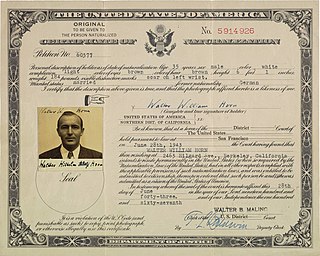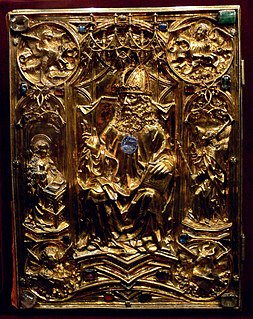 W
WThe Imperial Regalia, also Imperial Insignia, are regalia of the Holy Roman Emperor. The most important parts are the Imperial Crown, the Imperial orb, the Imperial sceptre, the Holy Lance and the Imperial Sword. Today they are kept at the Imperial Treasury in the Hofburg palace in Vienna, Austria.
 W
WThe Holy Lance, also known as the Lance of Longinus, the Spear of Destiny, or the Holy Spear, is the lance that pierced the side of Jesus as he hung on the cross during his crucifixion.
 W
WWalter William Horn was a German-American medievalist scholar noted for his work on the timber vernacular architecture of the Middle Ages.
 W
WThe Imperial Cross is part of the Imperial Regalia of the Holy Roman Empire. It served as the container for the two "Great Relics of Christ" : the Holy Lance in its horizontal arms and the reliquary of the True Cross in the lower shaft. It is thus the original reliquary of the Imperial relics. The Imperial cross is kept in the Imperial Treasury in the Hofburg. It has been suggested that the cross was probably created some time around 1024–25 or 1030 in Lotharingia. A somewhat earlier creation as a commission of Conrad's predecessor Henry II (1002–1024) is also found in scholarly literature.
 W
WThe Imperial Crown of the Holy Roman Empire, a hoop crown with a characteristic octagonal shape, was the coronation crown of the Holy Roman Emperor, probably from the late 10th century until the dissolution of the Holy Roman Empire in 1806. The crown was used in the coronation of the King of the Romans, the title assumed by the Emperor-elect immediately after his election. It is now kept in the Imperial Treasury at the Hofburg in Vienna, Austria.
 W
WThe Imperial Sword is one of the four most important parts of the Imperial Regalia (Reichskleinodien) of the Holy Roman Empire. During a coronation, it was given to the emperor along with the Imperial Crown (Reichskrone), Imperial Sceptre (Reichszepter), and the Imperial Orb (Reichsapfel). All four parts of the Imperial Regalia are displayed in the Imperial Treasury at the Hofburg Palace in Vienna, Austria.
 W
WThe so-called Sabre of Charlemagne is an early sabre of Hungarian (Magyar) type which has exceptionally been preserved as part of the Aachen regalia of the Holy Roman Empire. Along with the rest of the imperial regalia from both Aachen and Nuremberg, it is now kept in the Hofburg Palace, Vienna.
 W
WSaint Stephen's Purse is a rectangular gold 9th century reliquary studded with gem stones that is part of the Imperial Regalia of the Holy Roman Empire. It consists of a purse containing soil that is claimed to be soaked with the blood of St. Stephen. It is held in the Kunsthistorisches Museum in Austria.
 W
WThe Vienna Coronation Gospels, also known simply as the Coronation Gospels, is a late 8th century illuminated Gospel Book produced at the court of Charlemagne in Aachen. It was used by the future emperor at his coronation on Christmas Day 800, when he placed three fingers of his right hand on the first page of the Gospel of Saint John and took his oath. Traditionally, it is considered to be the same manuscript that was found in the tomb of Charlemagne when it was opened in the year 1000 by Emperor Otto III. The Coronation Evangeliar cover was created by Hans von Reutlingen, c. 1500. The Coronation Evangeliar is part of the Imperial Treasury (Schatzkammer) in the Hofburg Palace in Vienna, Austria.